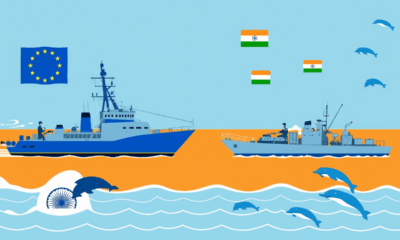Travel
Germany flight chaos: Why do freezing temperatures wreak havoc for airports?
Delays and cancellations snarled runways for several days.
Air transport in Germany was hit by freezing temperatures and extreme weather earlier this week with hundreds of flights grounded.
Airports warned of severe disruption due to the extreme cold which created dangerous conditions for aircraft on the ground and in the air.
Hundreds of flights were delayed or cancelled on 17 and 18 January.
Travellers were advised to check the status of their flights before heading to airports.
Travellers intending to fly from airports in Germany this week were warned to expect disruption after icy conditions and snowfall hit the country.
The freezing temperatures were causing hazardous conditions for pilots with Frankfurt airport is impacted the most. The travel hub was thrown into chaos with significant delays and cancellations of flights.
On Wednesday, 570 of the 1,047 scheduled arrivals and departures were cancelled. More than 300 of the 1,000 flights scheduled for Thursday were also grounded.
Travellers were asked not to come to the airport if their flights were cancelled.
Munich airport was also affected, with 254 flights grounded.
In western Germany, Saarbruecken airport closed for the day on Wednesday, and Dusseldorf and Cologne/Bonn airports were also affected by delays and cancellations.
Lufthansa flights saw the most disruption as the airline has its bases at Frankfurt and Munich airports.
It was asking passengers to check the status of their flights on the company or airport websites in advance and not to go to the airport in the case of cancellations.
How does ice and snow affect flights?
For several days this week, the German Weather Service increased weather warnings for some areas to level four, or ‘extreme severe’.
At Frankfurt airport, warnings were issued of black ice. When this builds up on runways, it reduces the traction of aircraft and risks accidents.
Furthermore, although planes can be de-iced, they risk icing up again while taxiing along the runway, the airport said.
Freezing rain is also a problem for pilots when in the air. If ice builds up on aircraft wings it can destabilise the plane.
In December, Munich airport was forced to close for several days due to snowy conditions. One aircraft not in use at the time tipped backwards after snow built up on the fuselage.
German rail travel disrupted by icy conditions
German state rail operator Deutsche Bahn (DB) also warned of delays and cancellations due to the freezing conditions.
The company scrapped several long-distance connections and limited the maximum speed for its high-speed ICE trains to 200 kilometres per hour on Wednesday as a precautionary measure.
Travel
Wildfire warnings issued in the Canary Islands as millions prepare to holiday there
ADVERTISEMENT
As millions of holidaymakers prepare to head to the Canary Islands this summer, authorities have issued a wildfire pre-alert across the archipelago.
The warning, announced by the General Directorate of Emergencies on Sunday, applies to tourist hotspots El Hierro, La Palma, La Gomera, Tenerife and Gran Canaria.
It comes as the islands enter a high-risk fire period following the wet season, as hot, dry winds known as the ‘calima’ begin blowing in from the Sahara Desert.
Fires are common, but they haven’t slowed tourism
The risk of wildfire is nothing new for the Canary Islands.
The volcanic terrain, Mediterranean climate and fire-adapted vegetation – plants that have evolved to thrive in fire-prone environments – make them susceptible to summer blazes, and scientists say wildfires are part of the archipelago’s ecological rhythm.
Some of the worst occurred in 2023, when forest fires ravaged Tenerife, destroying more than 15,000 hectares of land and forcing 12,000 people to evacuate. The blaze was later found to have been started by arsonists.
This year, officials are urging tourists and locals alike to take extreme caution, warning against launching fireworks near forests and discarding cigarettes on dry ground.
But even as the fire warnings roll in, the Canaries’ appeal shows no signs of slowing down.
In 2024, the islands welcomed nearly 18 million tourists, including a record-breaking 15.5 million international arrivals. Among them, British travellers led the way, recording 6.3 million visits – up 500,000 from 2023.
Concerns about overtourism mount amid record arrivals
While the Canary Islands continue to attract record numbers of tourists, residents are increasingly voicing concerns about overtourism.
In April 2024, tens of thousands of islanders participated in protests, holding signs that read “the Canary Islands have a limit” while rallying against rising housing costs, environmental damage and the strain on public services.
Over Easter this year, about 80,000 hospitality workers in Tenerife, La Palma, La Gomera and El Hierrowalked out in a dispute with unions over pay.
The surge in short-term rentals has been especially contentious. Locals have reported getting priced out of their neighbourhoods as properties are converted into holiday lets, the cost of living soars and wages stagnate.
Despite these concerns, tourism remains a significant part of the Canary Islands’ economy, accounting for approximately 35 per cent of its GDP.
Tenerife still reigns supreme
After welcoming seven million tourists in 2024, Tenerife remains the most visited island.
Its year-round sunshine and wide beaches keep it a firm favourite among families, especially during the UK’s summer school break and throughout the winter months.
As the peak summer season picks up, local tourism boards have made no indication that the fire pre-alerts will disrupt travel plans.
But authorities remain focused on prevention this year.
More than 2,000 firefighters are on standby. Meanwhile, the government has distributed detailed safety advice, urging people to prepare a go-bag, stay informed and follow emergency evacuation or shelter-in-place instructions if fires erupt.
Travel
Violent turbulence hits Ryanair flight in Germany, forcing an emergency landing and injuring 9
By Euronews Travel with AP
Published on
ADVERTISEMENT
Severe storms in southern Germany forced a Ryanair flight to make an emergency landing late Wednesday after violent turbulence injured nine people on board, German police said in a statement Thursday.
The flight, travelling from Berlin to Milan with 179 passengers and six crew members, encountered turbulence so intense around 8:30 pm that the pilot was forced to make an unscheduled landing at Memmingen Airport in Bavaria.
Eight passengers and one crew member were hurt.
Three people were taken to the hospital in Memmingen for treatment; the other injured people were released after receiving outpatient treatment. As a precaution, all passengers were checked for injuries by the emergency services.
Authorities did not permit the plane to continue flying, and the airline arranged bus transport for passengers. Milan is about 380 kilometres south of Memmingen.
More bad weather expected in Germany
Elsewhere in the region, storms damaged several homes in Ulm, Baden-Württmberg, according to the German news agency dpa.
In the Donaustetten district, strong winds tore roofs off multiple row houses, rendering them uninhabitable, though no injuries were reported. Fire officials suspect a small tornado or waterspout caused the damage. The German Weather Service (DWD) is investigating, according to dpa.
Storm-related emergency calls also came from other areas in southern Germany, where damage was mostly limited to fallen trees and flooded basements.
The DWD warned of further storms on Thursday, 5 June, with hail, strong winds, and localised heavy rain expected.
Travel
Hikers ignored warnings before Mount Etna’s latest eruption, Sicilian officials say
Published on
ADVERTISEMENT
Despite warnings to stay away, hikers on Mount Etna were forced to flee this week after Italy’s most active volcano erupted.
Footage from the mountain shared on social media showed tourists scurrying down the slopes as ash rose into the sky. Authorities had issued alerts on Monday morning after signs of increased volcanic activity, but dozens ignored them and climbed toward the summit anyway.
“There was a big explosion and a crater collapsed but luckily it fell into a deserted area,” said Salvo Cocina, head of Sicily’s Civil Protection Department. “It’s very hard to block access [to Mount Etna] – you can’t fence it off.”
No one was injured and the alert level was lowered to the standard ‘yellow’ on Tuesday.
Why is Mount Etna so popular with hikers?
Experiencing a close-up volcanic eruption is a bucket-list event, and Mount Etna offers one of the most accessible opportunities to do it.
At 3,350 metres tall and 35 kilometres wide, the Sicilian giant frequently rumbles to life, offering a front-row seat to nature’s raw power.
Even when it’s active, many trails and paths remain safe to climb.
“[The experience is] a mix of awe and adrenaline,” says mountain guide Saro Trovato, who safely – and legally – climbed Mount Etna when it erupted inFebruary.
“Even from a distance, you can feel the heat radiating from fresh lava flows.”
But above 2,500 metres, hikers are legally required to travel with a qualified mountain guide, who can keep visitors safe as well as informed.
On Tuesday, many hikers were as high as 2,700 metres above sea level.
How to stay safe when visiting Mount Etna
Conditions can change quickly on the mountain.
On Monday, a pyroclastic flow – a fast-moving surge of gas, rock and ash – travelled two kilometres down the mountainside. It didn’t go further than the Valle del Leone, a natural containment area for lava flows, but any changes could have led to catastrophe.
Tourism presents other problems during eruptions, too. In February, Cocina said that tourists parked on narrow roads around Mount Etna had blocked access for emergency vehicles. Firefighters had to be deployed to manage the growing crowds.
This is why the authorities mandate mountain guides such as Trovato, who receive real-time updates from volcanologists and rescue teams and are trained to respond if conditions suddenly change.
“Always check volcanic activity updates from local authorities and respect any access restrictions,” he advises. Especially when the volcano starts to stir.
-
EU & the World4 days ago
Aurora Borealis Forecast: Where & When to See the Northern Lights Tonight
-

 Sports6 days ago
Sports6 days agoChampions League Final 2024-2025: PSG-Inter, official lineups
-

 Sports7 days ago
Sports7 days agoPSG-Inter, Nicolò Barella jokes about Gianluigi Donnarumma
-

 EU & the World5 days ago
EU & the World5 days agoRihanna’s Parents: About Her Late Dad Ronald Fenty & Mom Monica Braithwaite
-

 Sports7 days ago
Sports7 days agoPSG-Inter, Lautaro Martinez unveils recipe for finals
-

 Politics6 days ago
Politics6 days agoEU and India Forge Deeper Maritime Ties with Historic Joint Naval Exercise in the Indian Ocean
-

 Sports5 days ago
Sports5 days agoOfficial: Damien Comolli new general manager of Juventus.
-
Travel7 days ago
France saw record night train passengers in 2024, but can it keep up with booming demand?









